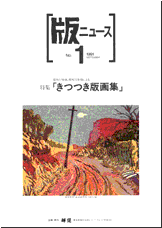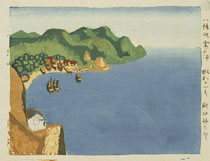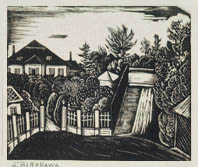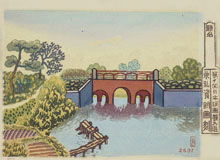| Introduction to Our Collection | Excerpted from the article in the Culture Columns of the | ||
| Newspaper, Nikkei, dated Oct.26.1995 | |||
| by@Naoteru Yoshitome | |||
 |
The term Sosaku-hanga is used for the art works drawn, | ||
| carved and printed by the artist. This genre covers the period | |||
| extending from the late Meiji to some years after World War | |||
| II, which is approximately the first half of the 20th century. | |||
| While the artists were active, their printed works were not | |||
| accepted as serious expression of art and were often mockingly | |||
| called 'half art', which resulted in scanty sales opportunities. | |||
| The unfavorable working conditions of the artists are almost | |||
| unimaginable today, because their works are easily classified | |||
| now under the genre of Sosaku-hanga and are appreciated all | |||
| over the world.@Unfortunate as the artists were, this environment helped them to keep intact their artis- | |
| tic temperament.@Without any urge to be conscious of the eyes of will-be-purchasers, they were entirely | |
| free to express themselves, dictated only by the artistic consciousness that arose from the depths of their | |
| souls.@This explains why their apparently plain and naive expressions speak most directly to our heart. |
 |
It was about 20 years ago that I first came into contact with | ||
| Sosaku-hanga. With some odd moments to spare, I dropped in at | |||
| an art gallery at Ginza, Tokyo, when one picture caught me by | |||
| surprise.@Though it only depicted a bay scene in spring in plain | |||
| and quiet colors, it seemed to overwhelm all the other pictures, | |||
| painted in oil, on the walls of the gallery. | |||
| I was stunned and stood speechless, learning only some moments later that it was a work of Sosaku-hanga | |
| by Azechi Umetaro, titled 'Kurinoura Inlet at Yawatahama Beach' published in 1936.@This unexpected blow | |
| was so shockingly fresh to me, because until this very moment I had always classified myself as a stranger | |
| to the beauty of fine arts. |
 |
From that moment on, I kept on purchasing any prints that | ||
| seemed congenial to me.@It somehow opened up for me a re- | |||
| newed life in which I paid no other attention than to pursuing | |||
| the works of and exploring the world of Sosaku-hanga. | |||
| I gave up my post in the publishing company I had worked in | |||
| for many years, and it was 8 years ago that I opened a gallery | |||
| specializing in Sosaku-hanga.@With my hobby turned into work, I had to think of some area of activity | |
| where I could simply enjoy myself without regard to business.@My conclusion turned out to be that of | |
| bringing to light forgotten artists of Sosaku-hanga. A privilege allowed to someone who can bring them | |
| to light may be the joy of discovering new variations of beauty and evaluating them afresh. | |
 |
I should perhaps give special thanks to my own deviation | ||
| from the beaten track of life, which brought me the honor | |||
| of contributing little bits to the history of the print art and | |||
| also appreciation by the families of the artists.@Let me | |||
| conclude this article by requesting you to inform me about | |||
| forgotten artists of Sosaku-hanga. | |||
|
|||||
| P.S. | |||||
| We would be very grateful if any visitor to this site could give us information about the artists listed | |||||
| below, whereabouts of their families, art works or documents. | |||||
| Sakaguchi Usasi@Shimizu Koichi@Murayama Kanko@Ishihara Juichi@Nozaki Shinemon@Narita Gyokusen | |||||
| Arai Toru (or Sueki Toru)@Matsuo Junichiro |
| KIKAI@Sosaku-hanga Collection | ||
| kikai@tbj.t-com.ne.jp@Naoteru Yoshitome | ||
|
|
Room-1 |
|
Room-2 |
|
Room-3 |
|
Room-4 |
|
|
Room-5 |
|
Room-6 |
|
Oliver Statler |
|
Mt.Fuji |
|
|
Top page |
|
Welcome to Kikai |
|
HAN News |
|
|
Japanese |